The Dholuo language, also known as Luo, belongs to the Luo-Acholi group of the Nilo-Saharan language family. The language is closely related to such African languages as Acholi and Lango. To be exact, these languages are considered to be mutually intelligible. The language is spoken in such countries as Kenya and Tanzania. The areas where the language is widely used are known as Homa Bay, Kisumu, Migori, Siaya, Kisii, Nyamira, Busia, Kakamega and Kavirondo Gulf area. There are about 4 million Dholuo speakers in Kenya. It is worth to mention that the total population of the Dholuo language speakers is estimated at about 4.2 million speakers.
Despite the fact that the Dholuo language has no official status in the countries used, it is considered to be a local language spoken by Luo people. Luo people use Dholuo in their everyday life, in areas of traditional culture and religious practice. Although the language is not considered to be official, it is taught in primary schools. Nevertheless, the English language is considered to be the language of subsequent instruction. Also, the Dholuo language can be heard on the radio.
Generally, the Dholuo language can be divided into two main dialects. They are Trans-Yala Luo dialect and South Nyanza Luo dialect. The Trans-Yala Luo dialect is mainly spoken in Central Nyanza province in Kenya. The other one, South Nyanza Luo, is spoken in various parts of the South Nyanza, as well as some parts of Central Central Nyanza province. Although the Dholuo language has no official standard dialect, exactly the South Nyanza dialect is considered to be the one. It is used both in education and broadcasting.
The written Dhulo language is based on the modified version of the Roman alphabet. Also, it is important to note that the same to many other African languages, the Dhulo language is considered to be a tonal language. There are four tones used to differentiate between identical words: high, low, falling, and rising.




